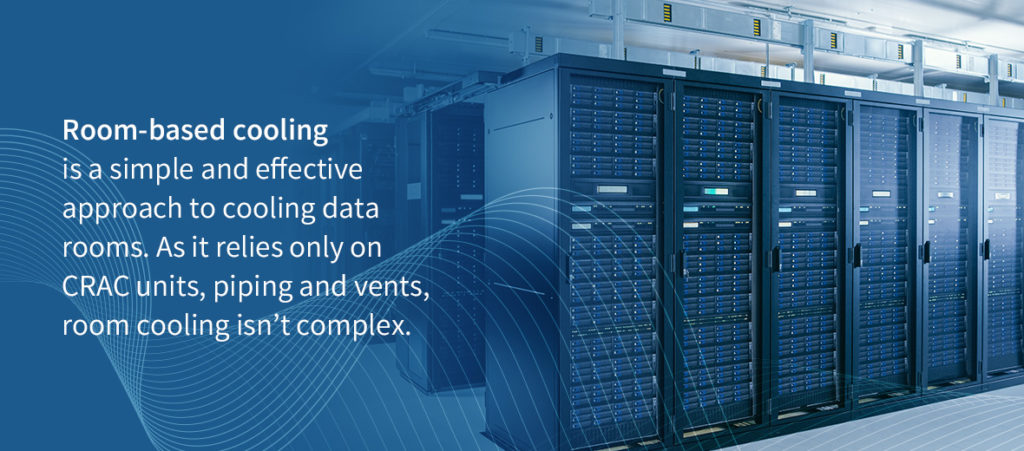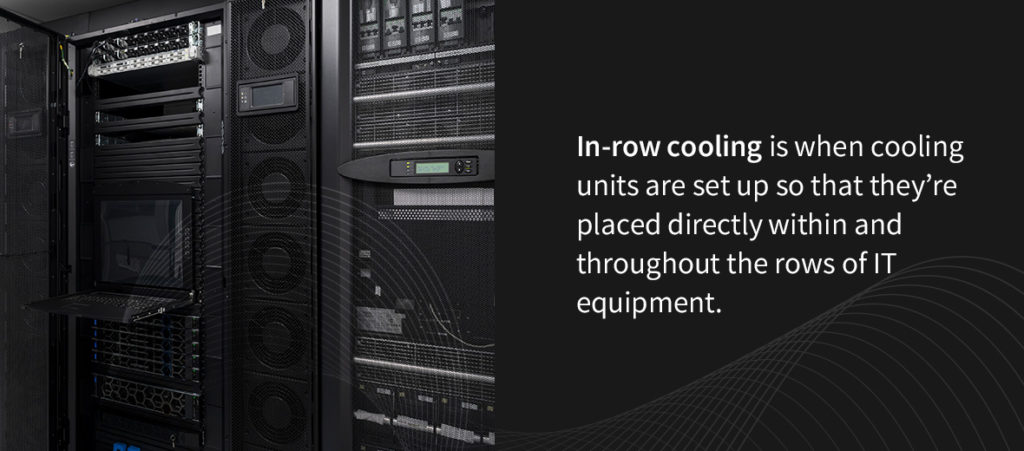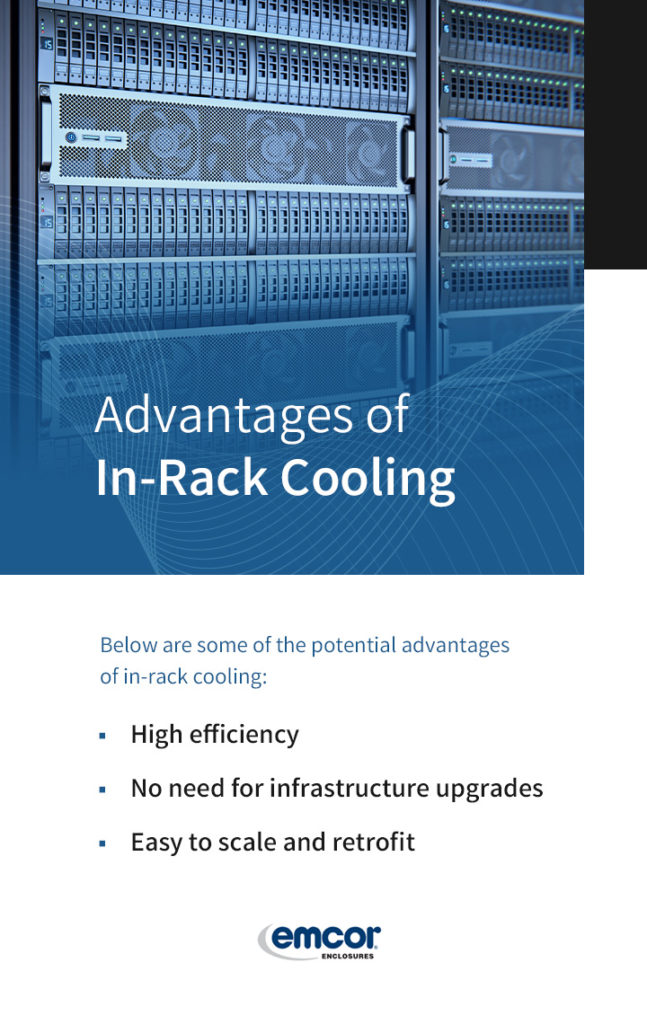Room, Row, Rack Cooling Comparison for Data Centers
Climate control in data centers is critical to the productivity, stability, and safety of organizations. Without adequate cooling capacity, excess heat generated by servers can impact components, leading to decreased response times or entire data losses when parts fail prematurely. To avoid this costly downtime, organizations must ensure that servers, especially those responsible for mission-critical operations, are kept consistently and sufficiently cool.
Globally, there are over 8,000 data centers, and as of 2021, 2,600 of them are in the United States. This number is expected to increase as research firms predict that the demand for data will reach 175 zettabytes by the year 2025 — a 146-fold increase from 2010. With the growing need for data storage, data centers are looking for ways to maximize IT equipment density to improve efficiencies.
However, as IT equipment density increases in data centers and server rooms, the cooling load requirements grow with it, meaning data centers must find the most energy-efficient and cost-effective ways to keep data centers cool.
Our guide to data center cooling methods explores the three types of server room cooling designs. We compare the cost-effectiveness and efficiency of room, row, and rack server room cooling systems so you can choose the optimal solution for your server room needs.
What Is Room Cooling?
Room cooling, also called perimeter cooling, is an approach to data center cooling that uses computer room air conditioners (CRAC) positioned around the room’s perimeter to drive airflow throughout the room. Room cooling is considered the traditional approach to data center cooling.
In perimeter cooling, data center floors are designed to be raised, creating a floor void. CRAC units pump cold air into the void created by the raised floor. Floor vents deliver the cold air from the floor to the front of the data server racks that face each other, also referred to as the cold aisle. As hot air is exhausted out the back of the server racks, it returns to the CRAC unit for recirculation. This approach allows cool air to circulate through the room, mix with warm air and bring down the overall temperature of the space by eliminating hot spots.

Advantages of Room Cooling
Room cooling, being the conventional server room cooling design, has a few distinct advantages over newer approaches to cooling, mainly having to do with the layout and size of a given data center.
Below are the benefits of in-room or perimeter cooling:
- Simplicity: Room-based cooling is a simple and effective approach to cooling data rooms. As it relies only on CRAC units, piping and vents, room cooling isn’t complex. With a limited number of components, room cooling systems are easy to maintain and operate.
- Cost-effectiveness: Because of the streamlined installation requirements for room cooling, it’s also a relatively cost-effective server room cooling method. The only initial costs are the cooling units and the piping, making it advantageous for fast, affordable installation. It also offers cost-effectiveness based on economies of scale. As the rack power density increases, the cost decreases because the model occupies a relatively smaller footprint as more server racks are added.
- Configurable design: With room cooling, IT professionals can quickly change the cooling airflow pattern by reconfiguring the floor vents. So as racks are added, removed, or repositioned, the system can be adjusted accordingly. Additionally, this provides for custom cooling loads at the server rack level, allowing vents to direct more airflow to priority racks that require a higher cooling load.
- Natural redundancy: Since room cooling provides one common and uniform airflow path to the entire room, the method allows for natural redundancy. Low-density IT equipment can share the cooling load across all racks.
Disadvantages of Room Cooling
Despite the simplicity and cost-effectiveness of room cooling, it does have some distinct disadvantages, especially for operations that have variable cooling load requirements or have unique infrastructure characteristics that affect how the airflow moves through the space.
Below are the possible disadvantages of room cooling:
- Higher energy costs: Room-based cooling may result in wasted cooling capacity, leading to higher energy costs. Room cooling essentially moves the air throughout the room rather than directing cool air directly at a server rack or row, meaning it uses more power to eliminate hot spots.
- Lower efficiency for high-density rooms: While room cooling may be effective for rooms with a low density of IT equipment that don’t need substantial or varying cooling loads, the method is not as efficient for high-density rooms. If server racks require much cooler air to be pumped directly at them to keep them cool, then perimeter cooling won’t be an effective solution. If more air is needed at a colder temperature, room cooling is not ideal.
- Efficiency is subject to room layout: Room cooling efficiency may also be challenged by the physical space itself, including its shape, layout and any infrastructure obstructions. Overhead lighting or cables can obstruct airflow, making it difficult to predict whether the airflow will directly reach IT equipment with the cooling load that’s necessary. Additionally, it’s important to consider how to route piping through a room cooling design so that it remains easily serviceable.
What Is Row Cooling?
In-row cooling is when cooling units are set up so that they’re placed directly within and throughout the rows of IT equipment. Row cooling is becoming a common alternative to perimeter or room-based cooling.
Being positioned within the rows allows row cooling units to have a more direct cooling effect on IT equipment. Row cooling units are positioned to serve one row of server racks, allowing them to have a much more well-defined airflow path.
With in-row cooling, the airflow can be either directed from below, like with room cooling, or from overhead. Floor-mount row cooling uses CRAC units positioned within the rows, resulting in a hot and cold aisle layout, which is also called a close-coupled system. Overhead CRAC units are suspended from the ceiling directly overtop the server rack rows, directing airflow from above.

Advantages of Row Cooling
Because row cooling eliminates the need for a raised floor and allows for better direction of airflow, this server room cooling system offers specific advantages over room cooling, particularly financial and energy efficiency benefits, as well as benefits for the IT technology.
Compared to room or perimeter cooling, row cooling offers the following advantages:
- Targeted redundancy: Row cooling is a more efficient way to deliver specific cooling loads to specific rows of server racks. This allows for targeted redundancy that’s needed for certain server racks that require higher cooling loads for mission-critical applications. With row cooling, one row can operate with higher power and one can operate with lower power applications.
- Improved efficiency: Row cooling provides better energy efficiency in server rooms with high-density applications. Having too many coolers for the space results in added energy costs, which is often the case in perimeter cooling with multiple CRAC units supplying cooling within the raised floor. Additionally, because row cooling leverages overhead cool air dropping down toward the racks, it requires less fan power, making it a more energy-efficient design.
- Lower infrastructure and maintenance costs: Row cooling may also result in reduced infrastructure, installation, and maintenance costs overall. Overhead row cooling doesn’t require the raised floor plenum, meaning there’s no need to invest in constructing or maintaining it. This can reduce operating expenses for in-row cooling data centers.
Disadvantages of Row Cooling
Though row cooling offers clear advantages over room cooling in many cases, it also has potential drawbacks if not used in the right applications. Row cooling eliminates the need for a raised floor, provides more efficient airflow and may reduce energy costs, but it also requires the right data center with high enough density IT equipment for it to be economically feasible.
Below are the main disadvantages of row cooling:
- Requires row organization for IT equipment: Row cooling requires IT equipment to be positioned in rows within the room for it to be effective. For small data center rooms with only a few server racks, a singular server rack, or a room that doesn’t permit server racks to be positioned in rows, the advantages of row cooling won’t translate. In these cases, perimeter cooling may make more sense.
- Better for rectangular-shaped rooms: The space itself, including its geometric shape, matters when installing row cooling. Rectangular-shaped rooms are conducive to uniform rows of server racks. If a data center is established in an odd-shaped room with sloped ceilings, more cooling units may be required, increasing the cost.
- Not suitable when cooling needs are too low or high: For data centers that are small or have a low amount of IT equipment, row cooling isn’t necessary as perimeter cooling can often do a sufficient job of keeping ambient air at a low enough temperature for servers. Conversely, if certain servers have extreme cooling needs and with many mission-critical servers requiring redundancy, then row cooling may not be sufficient. In this case, in-rack cooling may be the safer option.

What Is In-Rack Cooling?
In-rack cooling refers to a server room cooling system that uses CRAC units dedicated to one server rack. With the in-rack server room cooling design, the cooling unit is mounted directly to the rack or within it. Having one CRAC unit dedicated to one server rack allows for the shortest, most precise path of airflow to the server.
In-rack cooling allows designers to select specific CRAC capacities based on the individual needs of each server. For this reason, in-rack cooling can be installed in either small data centers with one or a few servers, or it can solve the cooling needs of high-density applications.
Advantages of In-Rack Cooling
In-rack cooling has many of the same advantages as row-cooling. Like in-row cooling, rack cooling is more efficient than perimeter cooling because it has a shorter airflow path. In-rack cooling has other distinct advantages compared to in-row cooling that may make it a viable option for high-density data centers or small, retrofitted server rooms.
Below are some of the potential advantages of in-rack cooling:
- High efficiency: In-rack cooling uses the most efficient airflow path, as the cold air travels the shortest distance compared to the other server room cooling methods. As with in-row cooling, the fan power required to blow the cold air is much lower, meaning increased efficiency and potentially reduced energy costs relative to the amount of cooling capacity obtained.
- No need for infrastructure upgrades: In data centers that strictly use in-rack cooling and not other server room cooling methods, there is no need to construct the elevated flooring to install CRAC units in-floor. There’s also no need to install overhead units that occupy overhead space. In-rack cooling doesn’t require any additional infrastructure upgrades while taking up the smallest footprint.
- Easy to scale and retrofit: If redundancy is needed or the IT equipment expands, it’s easy to install an additional in-rack unit on an existing rack or a new rack without major retrofits.
Disadvantages of In-Rack Cooling
In-rack cooling is the most energy-efficient method of server room cooling when it comes to large data centers with high-density IT equipment. However, this results in some clear disadvantages for some types of data centers or server rooms, particularly when it comes to the initial investment costs.
Below are some of the disadvantages of an in-rack server room cooling design:
- Highest initial cost: In-rack cooling carries the highest first cost burden when dealing with multiple racks. The increase in the number of cooling units needed, along with the required piping, drives up the capital cost of the system. With rack-based cooling, rear containment is required, also adding to the total initial cost. This high initial cost is offset only when density increases, earning a better return on investment the higher the rack power density.
- No natural redundancy: In perimeter cooling, there is a natural redundancy of cooling available as the cooling design allows for the entire room to be cooled and all equipment shares the same cooling load. With rack-based cooling, there’s no natural redundancy, meaning that redundancy needs to be added via a dual path for each rack. Though this would ensure redundancy for high-powered racks, it’s not economical initially.
Choose Emcor Enclosures for Data Center Cooling
Choosing the right server room cooling method comes down to the type and size of space, the density of server racks and the required scalability of the data center’s cooling solution. These factors will affect how efficient the cooling system needs to be and ultimately how much it will cost to maintain and operate.
The more a data center’s cooling system can maximize its direct airflow path to as many server racks as possible, the more efficient it is and the more economical it becomes. However, the trade-off is that highly efficient systems that cover shorter airflow distances are costlier to install.
Performing analysis with the help of a mechanical engineer will allow your data center to choose the optimal server room cooling system for your needs, whether that’s the room, row, or rack cooling method, or a combination of them.
Emcor Enclosures is a leading manufacturer of data server protective enclosures that keep IT equipment stable, secure, and reliable. Our team of experts have your cooling options covered: